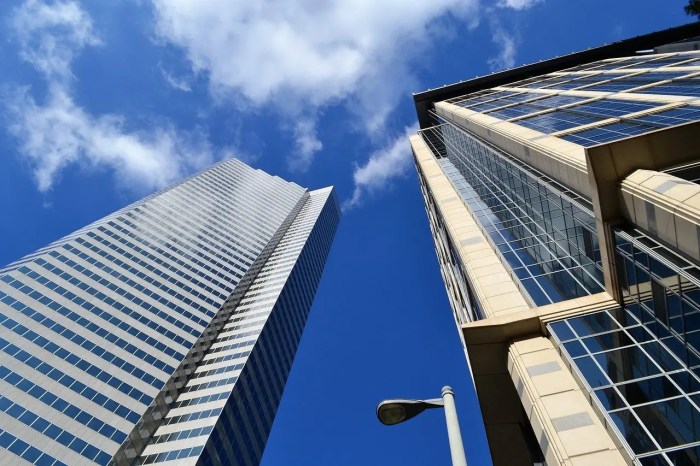
Commercial construction growth stands at the forefront of an evolving industry, revealing the dynamic forces shaping our urban landscapes and infrastructure. With rapid advancements in technology and innovative building practices, this sector is not just expanding; it’s transforming. Key market trends indicate a robust future, influenced by emerging tools and techniques that promise to enhance efficiency and sustainability.
This discussion delves into the current market trends that are propelling growth in commercial construction, including the impact of economic indicators, regulatory frameworks, and the ever-present challenges that companies face. By exploring these aspects, we gain a clearer picture of the future of construction and the strategies that industry players are employing to thrive in this competitive environment.
Commercial Construction Market Trends
The commercial construction sector is currently experiencing significant growth driven by a combination of economic recovery, technological advancements, and an increasing demand for sustainable building practices. As businesses expand and invest in new facilities, the landscape of commercial construction is evolving rapidly, providing ample opportunities for industry players.Several key trends are emerging within the commercial construction market that are shaping its future direction.
These include the incorporation of advanced construction technologies, a shift towards sustainable practices, and a growing emphasis on safety and efficiency in building processes.
Current Growth Drivers in Commercial Construction
The growth of the commercial construction market is influenced by various factors that contribute to its robust expansion. Some of the most notable drivers include:
- Economic Recovery: Following the impacts of global events such as the pandemic, many regions are witnessing a rebound in economic activity, leading to increased investments in commercial properties.
- Increased Demand for Warehousing and Logistics: The rise of e-commerce has fueled a demand for distribution centers and warehouses, prompting new construction projects across urban and suburban areas.
- Government Infrastructure Investments: Numerous governments are allocating funds to improve infrastructure, which creates opportunities for commercial construction in transportation, healthcare, and educational facilities.
Emerging Technologies in Construction
Emerging technologies are playing a critical role in transforming construction practices, enhancing efficiency, and reducing costs. Notable technologies include:
- Building Information Modeling (BIM): This technology allows for the creation of digital representations of physical and functional characteristics of buildings, facilitating better planning and collaboration.
- 3D Printing: The advent of 3D printing technology in construction is enabling faster building processes, allowing for the creation of complex structures with precision and minimal waste.
- Drone Technology: Drones are increasingly used for site surveys, monitoring progress, and conducting inspections, providing real-time data that enhances project management.
Market Expansion and Forecast Projections
The commercial construction market is on track for substantial growth over the next decade. According to industry reports, the global commercial construction market is projected to reach approximately $15 trillion by 2030, growing at a compound annual growth rate (CAGR) of around 5.4%. This growth is bolstered by the following statistics:
The global commercial construction sector is expected to witness an annual growth rate of 5.4% from 2021 to 2030, highlighting the recovery and expansion post-pandemic.
As regions continue to invest in infrastructure and commercial developments, the anticipated growth will be fueled by urbanization trends, particularly in developing nations where commercial real estate is seeing increased demand. These projections underline the importance of staying ahead of market trends and adapting to the evolving landscape of commercial construction.
Factors Affecting Commercial Construction Growth

The commercial construction sector is influenced by various factors that determine its growth trajectory. From economic conditions to regulatory frameworks, understanding these influences is crucial for stakeholders looking to navigate the complexities of the market. Let’s delve into the key elements that drive the expansion of commercial construction and how they interact with broader economic indicators.
Key Factors Contributing to Commercial Construction Expansion
Several fundamental factors contribute to the growth of commercial construction, each playing a vital role in shaping the landscape of the industry. Awareness of these factors is critical for effective planning and investment.
- Economic Conditions: Economic growth, measured through GDP, directly correlates with increased demand for commercial spaces. When businesses expand, they seek new office spaces, retail outlets, and industrial facilities, driving construction projects.
- Interest Rates: Lower interest rates can stimulate construction by making financing more attractive. Conversely, higher rates can dampen demand as borrowing costs climb.
- Population Growth: An increasing population necessitates more commercial infrastructure, such as shopping centers and office buildings, to accommodate the growing workforce and consumer base.
- Technological Advancements: Innovations in construction technologies, such as Building Information Modeling (BIM) and modular construction, enhance efficiency and reduce project costs, fostering growth.
Economic Indicators Shaping Construction Demand
Economic indicators serve as vital tools for predicting the demand for commercial construction. They provide insights into the overall health of the economy and guide decision-making for investors and developers.
- Unemployment Rate: A declining unemployment rate often signals economic growth, leading to increased consumer spending and, consequently, a higher demand for commercial spaces.
- Consumer Confidence Index: A high consumer confidence index suggests that consumers are willing to spend, prompting businesses to expand and invest in new commercial properties.
- Construction Spending Reports: Regular updates on construction spending can indicate trends in the commercial sector, helping stakeholders make informed decisions about future projects.
Regulatory and Environmental Considerations Impacting Projects
Regulatory and environmental factors play a significant role in shaping commercial construction timelines and costs. Understanding these considerations is essential for successful project execution.
- Zoning Laws: Local zoning regulations dictate land use and can either promote or hinder development projects. Compliance with these laws is crucial for obtaining necessary permits.
- Environmental Regulations: Stricter environmental regulations may increase project costs and timelines as developers must adhere to sustainability standards and conduct environmental impact assessments.
- Building Codes: Compliance with relevant building codes ensures safety and structural integrity but can also add complexity and costs to the construction process.
- Permit Approval Processes: Lengthy permit approval processes can delay projects and increase costs. Understanding the local regulatory landscape is essential for timely project delivery.
Challenges in the Commercial Construction Industry
The commercial construction industry, while thriving, faces a myriad of challenges that can significantly impact project timelines, budgets, and overall success. Companies must navigate issues ranging from labor shortages to supply chain disruptions, each of which can pose serious risks to project execution and profitability. Understanding these challenges is crucial for stakeholders to devise effective strategies that can mitigate risks and enhance resilience in their operations.
Common Challenges Faced by Commercial Construction Companies
Navigating the commercial construction landscape involves confronting several persistent challenges that can hinder progress. These challenges include not only labor shortages and supply chain disruptions but also regulatory compliance, financing issues, and the increasing complexity of projects. Each of these factors requires careful consideration and strategic planning to overcome.
- Labor Shortages: The construction industry has been grappling with a significant shortage of skilled labor. With an aging workforce and insufficient new entrants, companies often face delays and increased costs as they struggle to find qualified workers.
- Supply Chain Disruptions: Global events, such as the COVID-19 pandemic, have highlighted the fragility of supply chains. Delays in material delivery and rising costs can push project timelines back, impacting overall productivity.
- Regulatory Compliance: Navigating the maze of local, state, and federal regulations can be daunting. Non-compliance can lead to costly fines and project delays, making it essential for companies to stay informed and agile.
- Financing Issues: Securing funding for projects can be challenging, especially in uncertain economic climates. Fluctuating interest rates and investor confidence can affect a company’s ability to initiate or complete projects.
- Project Complexity: As building designs become more intricate and technology-driven, managing project complexity requires advanced planning and skilled project management to prevent overruns and miscommunication.
Impact of Labor Shortages and Supply Chain Disruptions on Project Execution
Labor shortages and supply chain disruptions are two of the most pressing challenges in the commercial construction sector, and their impacts are far-reaching. Labor shortages contribute to extended project timelines and increased labor costs, as companies may need to offer higher wages to attract talent. This, in turn, can inflate overall project budgets. Supply chain disruptions can exacerbate these issues by delaying the delivery of essential materials, which may lead to stalled projects and increased idle time for labor.
“Labor shortages and supply chain issues not only challenge timelines but can also significantly impact the financial health of construction projects.”
To illustrate, a recent study found that nearly 70% of construction firms reported project delays directly tied to labor shortages. Similarly, a survey indicated that supply chain delays added, on average, 20% to project costs due to increased material prices and extended timelines.
Strategies for Addressing Risks Associated with Commercial Construction Projects
Addressing the myriad risks in commercial construction requires a proactive approach and the implementation of strategic measures. Companies can employ various strategies to mitigate these risks effectively.
- Investing in Workforce Development: Training programs and partnerships with trade schools can help bridge the skills gap and attract new workers into the industry.
- Building Stronger Supply Chain Relationships: Developing relationships with multiple suppliers can provide contingency options, minimizing the impact of disruptions.
- Utilizing Technology: Implementing project management software and BIM (Building Information Modeling) can enhance efficiency and communication among stakeholders.
- Regular Risk Assessments: Conducting risk assessments throughout the project lifecycle can help identify and address potential issues before they escalate.
- Flexible Project Scheduling: Incorporating flexibility in project timelines allows for adjustments in response to unforeseen delays, helping to maintain overall project momentum.
By understanding and strategically addressing these challenges, companies in the commercial construction sector can enhance their resilience, ensuring successful project execution and sustainable growth in a competitive market.
Ending Remarks

In summary, the trajectory of commercial construction growth reflects a vibrant and adaptive industry poised for significant advancements. As we navigate challenges like labor shortages and supply chain disruptions, the innovative solutions and strategies emerging from these trials will undoubtedly shape the future landscape of commercial development. The ongoing evolution in this sector not only underscores the importance of adaptability but also highlights the potential for sustainable practices that benefit both businesses and communities alike.
FAQs
What are the current trends in commercial construction?
Current trends include sustainable building practices, the use of advanced technologies like BIM and prefabrication, and a focus on smart buildings that improve energy efficiency.
How do economic indicators affect commercial construction?
Economic indicators such as GDP growth, employment rates, and consumer spending directly influence demand for commercial spaces, impacting construction projects and investment decisions.
What are common challenges in the commercial construction industry?
Common challenges include labor shortages, fluctuating material costs, supply chain disruptions, and regulatory hurdles that can delay project timelines.
How can companies address labor shortages?
Companies can tackle labor shortages by investing in training programs, promoting a diverse workforce, and enhancing job appeal through competitive wages and benefits.
What role does technology play in commercial construction?
Technology plays a critical role by improving efficiency, safety, and accuracy in construction processes, thereby streamlining project delivery and reducing costs.





